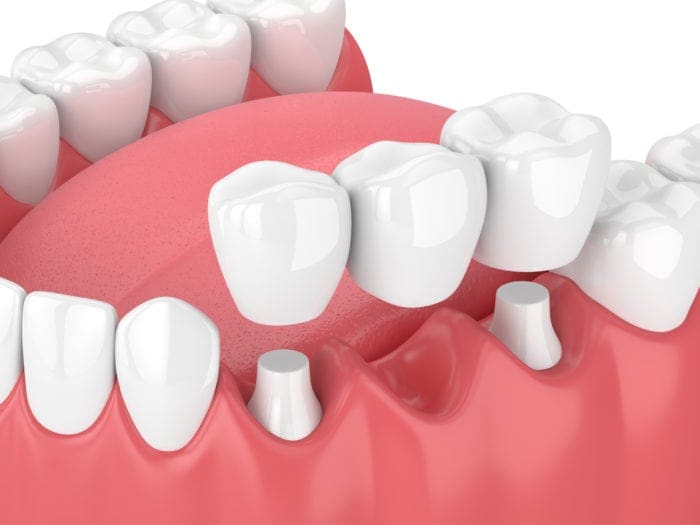A patient with one or more missing teeth may choose to restore their smile using a dental bridge. This restorative dentistry treatments allows our patients to eat and speak normally without the need for special oral hygiene.
Claremont Dental Institute uses state-of-the-art digital imaging and design software to create high-quality, life-like dental bridges in Claremont, CA. Modern dental materials mimic the enamel of human teeth, creating a flawless replacement for missing teeth.
Our team of skilled dentists uses their artistic eye, precision, and skill to design refined dental bridges that will fit comfortably. We will help you improve the overall appearance and function of your smile.

About Dental Bridges
We can use bridges and crowns to improve a tooth’s appearance, shape, alignment, and dental occlusion or bite. Gaps left by missing teeth can cause the remaining teeth to shift, resulting in a bad bite. Bridges and crowns help prevent this from happening.
The appearance of your smile is essential to living your best life. Missing or damaged teeth can cause you to hide your smile and may impact your quality of life. Missing teeth can also hurt your self-esteem as well as your oral health.
Replacing missing teeth with our quality dental restorations will improve the function of your bite. We can also prevent bone loss and damage to the jaw.
What is a Dental Bridge?
A traditional dental bridge is a dental prosthesis that our dental office provides to replace one or more of your missing teeth. It consists of two crowns that fit on either side of the gap left by the missing tooth or teeth. One or more false teeth, or pontics, connect the two dental crowns. Our dentist secures the traditional dental bridge in place with cement or metal clasps.
Why should I replace my missing teeth using a dental bridge?
Missing teeth can cause a number of problems including difficulty in eating, speaking, and affect the look of your smile. However, replacing your missing teeth with a dental bridge is an effective and long-lasting solution.
A dental bridge can improve your ability to chew food properly, prevent gum disease and reduce stress on remaining natural teeth.
It’s important to consult with our Claremont dentist to discuss if this treatment option is right for you. Our dentist will explain the procedure in detail, as well as provide information about any potential risks. We will help you make an informed decision about replacing your missing teeth using a dental bridge, so don’t hesitate to schedule a visit today.
The dental bridge process will vary depending on the type of bridge that you need. Your overall oral health and the number and location of your missing teeth also contributes to this decision.
Our Claremont Dental Institute dentist will explain your procedure to you in detail so that you fully understand your treatment. In just a few short visits, our patients have a restored smile and renewed sense of self-confidence.
Types of Dental Bridges
- Traditional Bridge: A traditional bridge requires the placement of porcelain crowns on the teeth adjacent to the missing tooth. The dental crowns act as anchors holding the dental bridge in place.
- Cantilever Bridge: Your dentist may suggest a cantilever bridge when there are only healthy teeth on one side of the missing tooth gap. This bridge is more delicate and is best for replacing missing front teeth that you will not use for heavy chewing.
- Maryland Bridge: For a Maryland bridge, the dentist bonds porcelain bridges to two adjacent teeth. This framework supports a custom dental restoration replacing the missing teeth.
All dental restorations are custom fabricated for optimal comfort and aesthetics. Our patients will work with our dentist to design a dental bridge that looks and feels like their natural teeth. Our custom restorations are practically indistinguishable from adjacent teeth and create a beautiful, confident smile.
What is an Implant-Supported Dental Bridge?
Our dentists can also secure a dental bridge using two or more dental implants. Dental implants improve the stability and function of the dental bridge. We preform the dental implant procedure for qualifying patients from the comfort of our Claremont, CA, dental office.
Our dentist will surgically place the implants into the jaw bone. We will leave your mouth to heal with the dental implants for a couple of weeks. They will fuse with your jaw bone. During this time our dentist will custom-design your final dental bridge.
Once the implants successfully integrate with your jaw, we will secure the dental bridge in place.
An implant-supported dental bridge is best because it doesn’t need removing healthy tooth structure from adjacent teeth. Implants also provide long-term support for the structure of the face and jaw.

Dental patient before and after implant-supported bridge at Claremont Dental Institute.
Dental Bridge FAQs
Navigating the world of dental restorations can bring up many questions, especially when considering a solution like a dental bridge. It is important to understand when you need one and how they work. Here, you will find answers to the common questions we get asked about dental bridges.
How many teeth can be in a bridge?
Bridges can replace multiple teeth. A traditional dental bridge can replace up to 4 teeth that sit next to each other. A dental implant-supported bridge can permanently replace any number of teeth.
How long does it take to get a dental bridge?
It can take anywhere between a couple of days to weeks. Treatment will depend on many factors such as how many missing teeth you have, do we need to fix other dental problems first, and the status of your gum health. We will give you a temporary bridge while you wait for your new bridge to be fabricated.
Is a dental bridge permanent?
No, traditional dental bridges are not permanent. Dental bridges do not last a lifetime. They should be replaced every five to ten years for optimal results. Both fixed and removable dental bridges are not considered a permanent dental restoration. Although, Implant-secured dental bridges are permanent.
How much does a dental bridge cost?
The cost of a dental bridge will depend on the number and location of the missing teeth as well as the type of bridge and materials chosen. It will also depend on how much coverage your dental insurance offers. We are happy to pre-estimate your portion of the total cost of treatment and file your dental insurance for you. We offer third party financing through Care Credit and LendingTree for patients who need help covering the cost of their dental bridge.
Will people notice my dental bridge?
We will design your dental bridge to blend in seamlessly with your smile. The bridge will match your surrounding natural teeth in terms of color, shape, and size making it virtually unnoticeable.
Can I eat a normal diet with a dental bridge?
Yes, after a short adjustment period, you should be able to consume a normal diet. Most patients have zero issues eating with a dental bridge once we place it. If you experience any discomfort when eating, this is a sign there is a problem, and you should schedule a visit with your dentist. We do advise avoiding hard or sticky foods to protect the bridge from damage.
Will a dental bridge affect my speech?
Most patients’ speech will not be affected by a dental bridge. However, you should expect a brief adjustment period once we place it. You will need to adjust to the feel of the bridge. This adjustment period should only last a short time. Any speech impediments caused by missing teeth will also likely improve once you get a dental bridge to replace your missing teeth.
If you are missing teeth, you may need a dental bridge in Claremont, CA to fill in the gap in your smile. Please call (909) 277-6919 to book an appointment or you can also request an appointment online by filling out the form.
